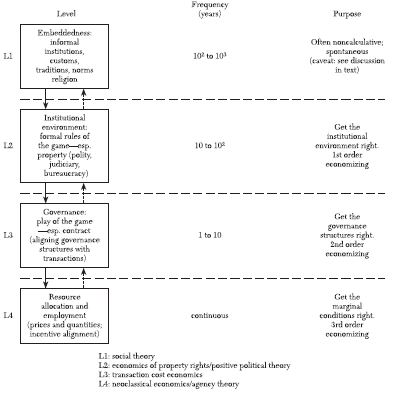

| Online: | |
| Visits: | |
| Stories: |

| Story Views | |
| Now: | |
| Last Hour: | |
| Last 24 Hours: | |
| Total: | |
The social sciences need each other
Read aguanomics http://www.aguanomics.com/ for the world’s best analysis of the politics and economics of water Academics spend a lot of time differentiating themselves from each other, both within and across fields. Economists will try to find “unique” data sets or invent “novel” theories to pull ahead of peers. They will also say how much better is their perspective than that of sociologists or psychologists.
The thing is that economists — and every other practitioner of the “social sciences”– are only providing one perspective of a complex topic — human behavior — that is perhaps best considered in diverse ways.*
I’m been thinking of a way to arrange social sciences along some sort of line that shows their differences and relations. Williamson’s diagram of institutions of varying durations (see the figure and read this post) inspires me to suggest the following arrangement.
Highest and slowest to change is the layer of culture that we are born into and affects our perspectives and actions. Anthropologists study culture, which they see as key to understanding our behavior, in terms of range and motivation.
Just below are the political scientists, who study the formal and official bodies we use to govern ourselves.
Then come the sociologists, who study groups and how group dynamics and identity affect our choices and behavior.
Going closer to the study of individual choice, cooperation and autonomy versus collection, we get the economists who think that individual (ir)rationality plays a big role.
Finally, at the most fleeting and individualistic level, we get the psychologists who try to understand how we internalize and rationalize what we do and do not do.
My big thought here is that its not just useful, but crucial, that we get different disciplinary perspectives on “an issue” (formal employment, say) before rushing to “solid” and “robust” conclusions.
What are your thoughts on this?
Bottom Line: The best part of working in an interdisciplinary environment is finding novel ways to understand what you think thought you understood.
* The hard sciences and humanities are also complementary at approaching their “larger dimensions” of human existence.
Source: http://www.aguanomics.com/2016/09/the-social-sciences-need-each-other.html



